CREATURE WITH THE ATOM BRAIN
B&W, 1955, 69 mins. 10 secs.
Directed by Edward L. Cahn
Starring
Richard Denning, Angela Stevens, S. John Launer, Michael Granger, Gregory Gaye
Arrow Video (Blu-ray) (US/UK RA/RB HD) / WS (1.85:1) (16:9), Sony (DVD) (US R1 NTSC)
THE WEREWOLF
B&W, 1956, 79 mins. 32 secs.
Directed by Fred F. Sears
Starring
Don Megowan, Joyce Holden, Eleanore Tanin, Steve Ritch
Arrow Video (Blu-ray) (US/UK RA/RB HD), Umbrella (Blu-ray) (Australia R0 HD) / WS (1.85:1) (16:9), Sony (DVD) (US R1 NTSC)
ZOMBIES OF MORA TAU
B&W, 1957, 69 mins. 4 secs.
Directed by Edward L. Cahn
Starring
Gregg Palmer, Allison Hayes, Autumn Russell, Marjorie Eaton
Arrow Video (Blu-ray) (US/UK RA/RB HD) / WS (1.78:1) (16:9), Sony (DVD) (US R1 NTSC)
THE GIANT CLAW
B&W, 1957, 74 mins. 11 secs.
Directed by Fred F. Sears
Starring
Jeff Morrow, Mara Corday, Morris Ankrum
Arrow Video (Blu-ray) (US/UK RA/RB HD) / WS (1.78:1) (16:9), Umbrella (Blu-ray) (Australia R0 HD), Sony, Mill Creek (DVD) (US R1 NTSC)
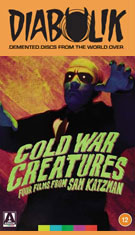
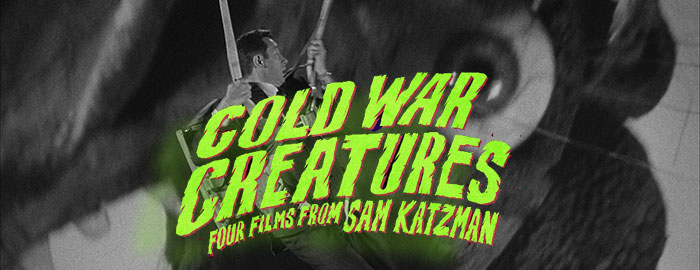
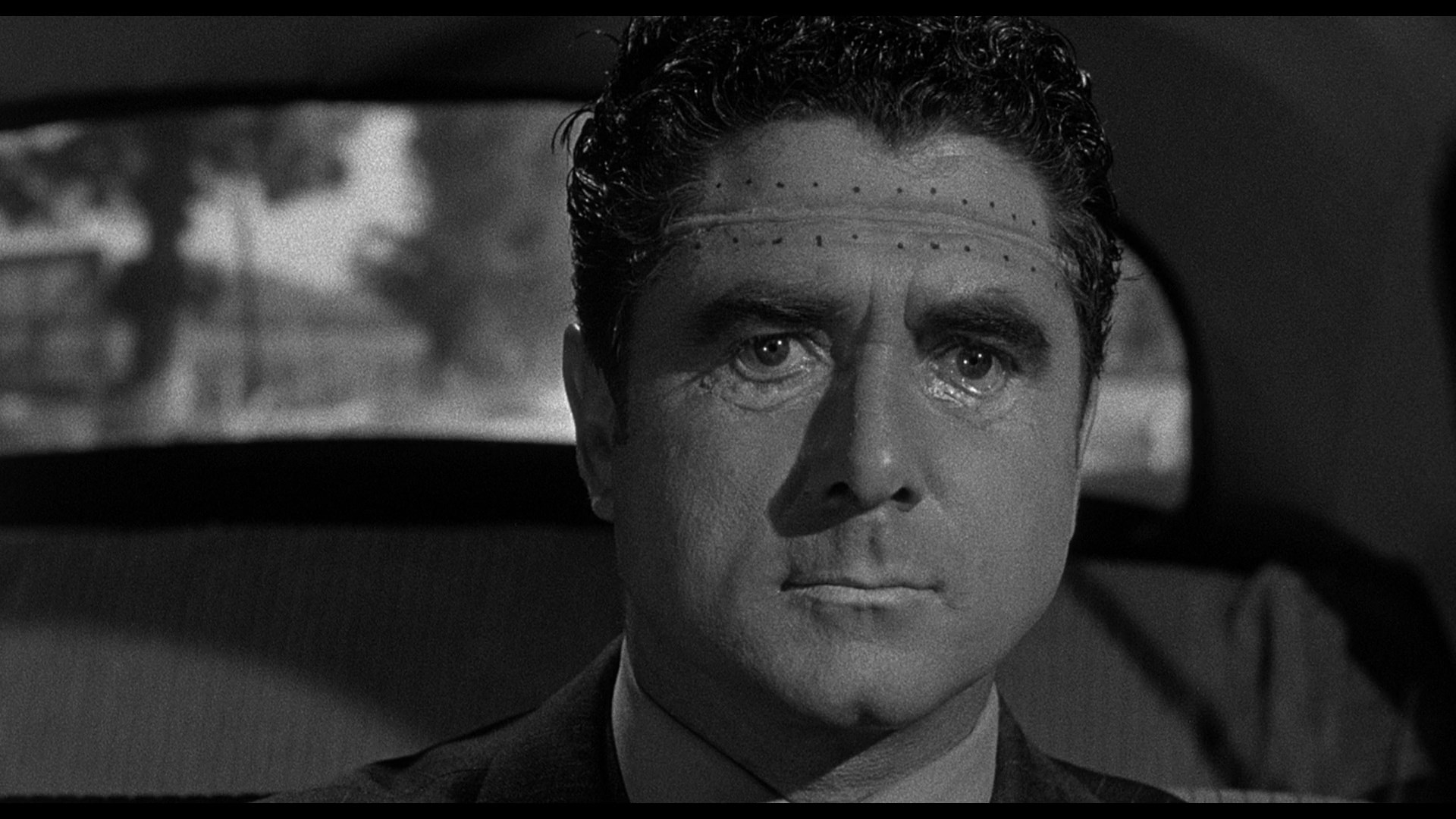 monster movies in the '50s designed to ride the wave of atomic age terror films that were packed
monster movies in the '50s designed to ride the wave of atomic age terror films that were packed 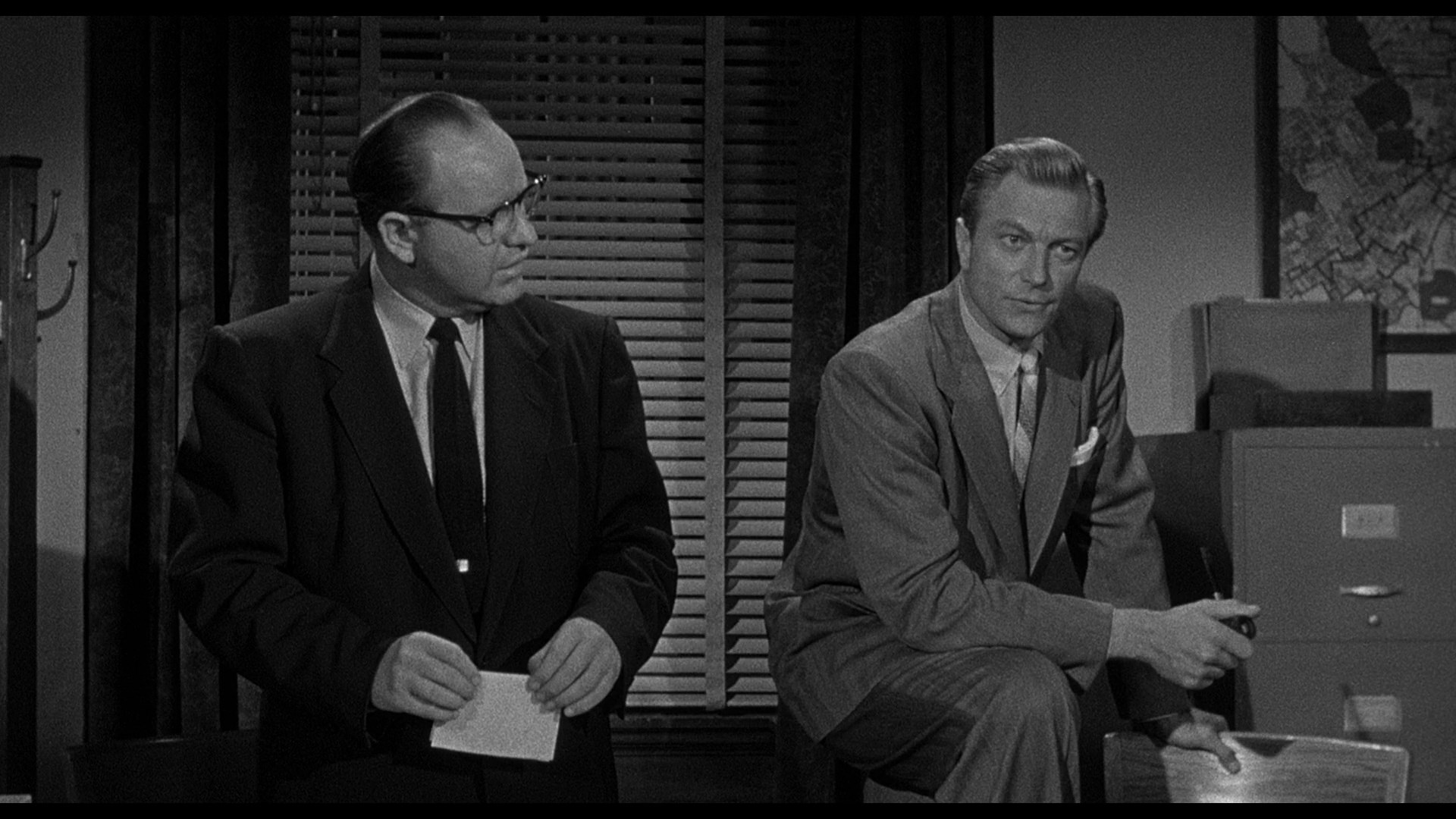 in teenagers from coast to coast. Cheaply made and devoid of any A-list stars, these films still made an impression on audiences who often lumped them in mentally with the flood of AIP movies that were making a killing at the same time.
in teenagers from coast to coast. Cheaply made and devoid of any A-list stars, these films still made an impression on audiences who often lumped them in mentally with the flood of AIP movies that were making a killing at the same time. 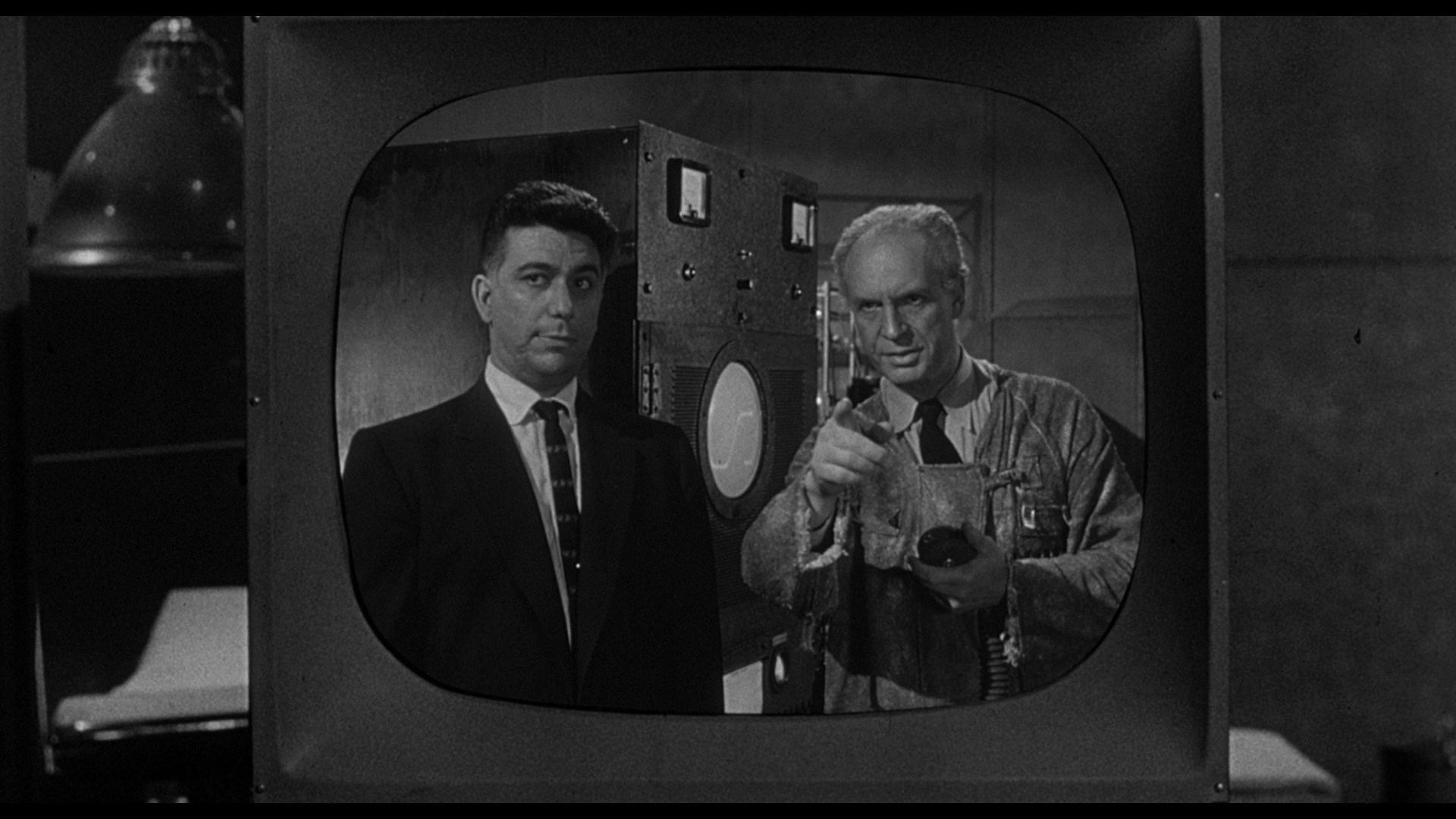 with fresh surgery scars on their foreheads. Now it's up to forensic specialist Chet Walker (Denning) and cop Dave Harris (Launer) to crack the case before the growing army of the
with fresh surgery scars on their foreheads. Now it's up to forensic specialist Chet Walker (Denning) and cop Dave Harris (Launer) to crack the case before the growing army of the 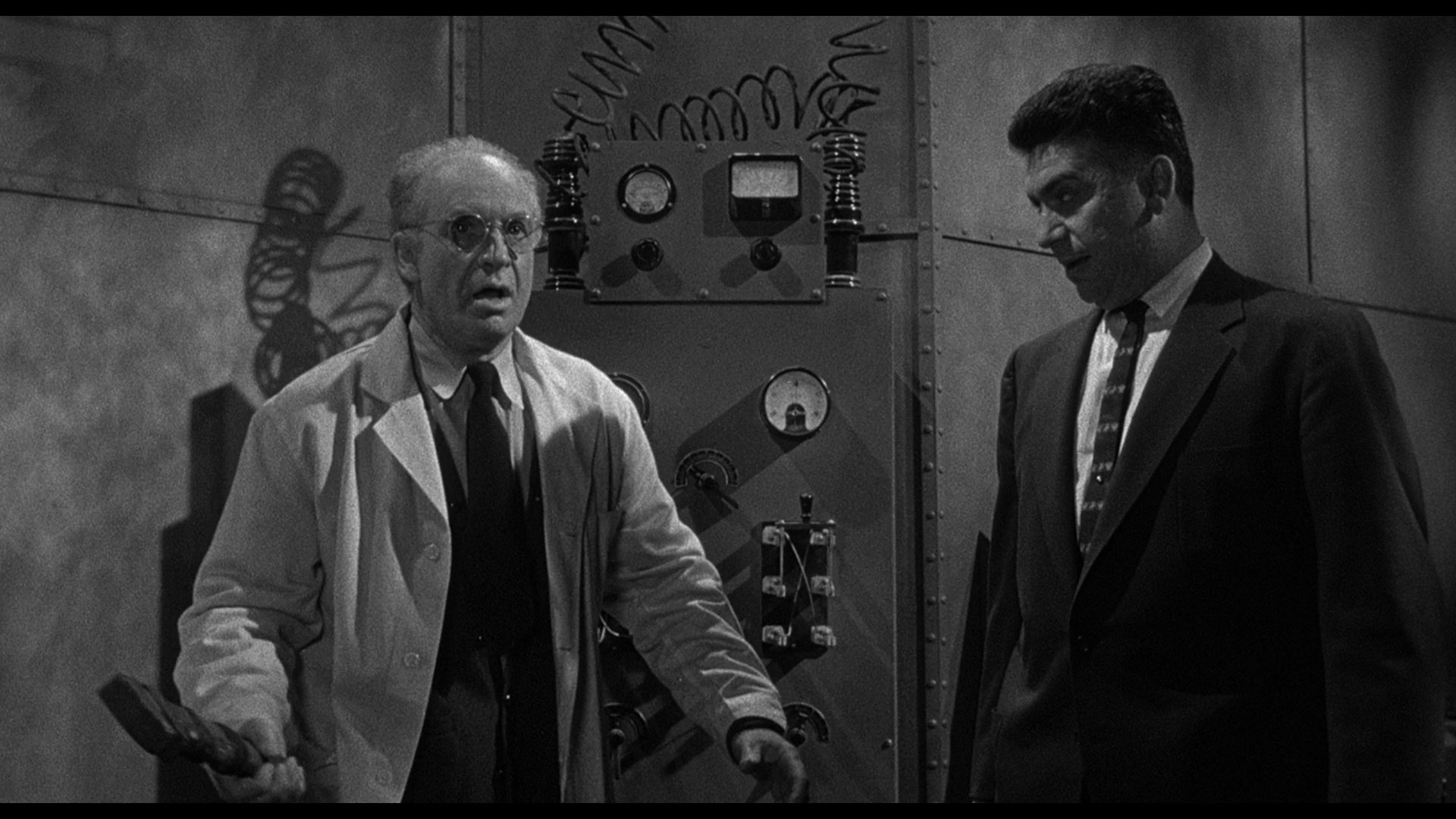 undead completes Frank's kill list.
undead completes Frank's kill list.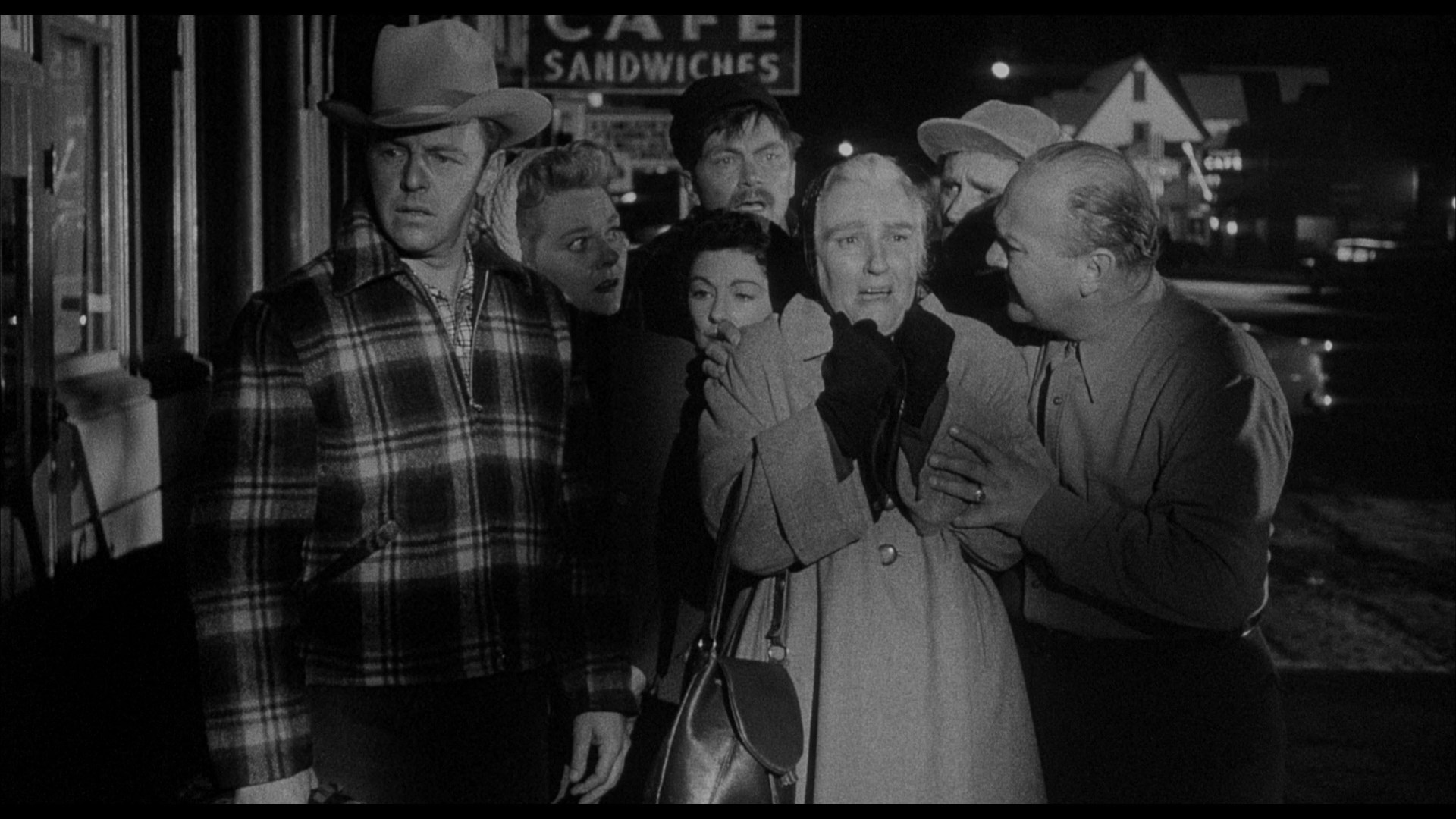 big plot moments, an open matte theatrical trailer,
big plot moments, an open matte theatrical trailer, 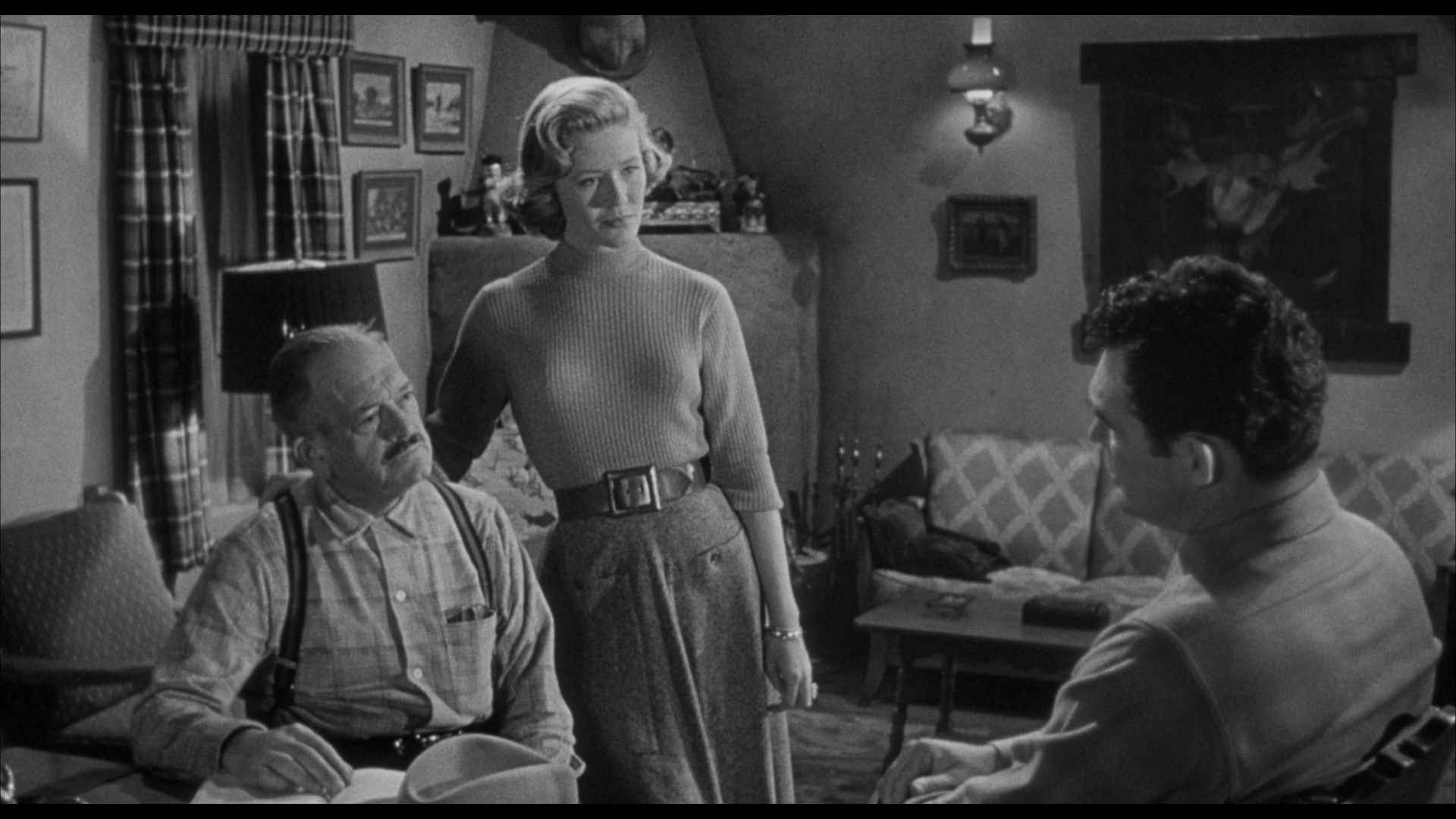 and an image gallery.
and an image gallery.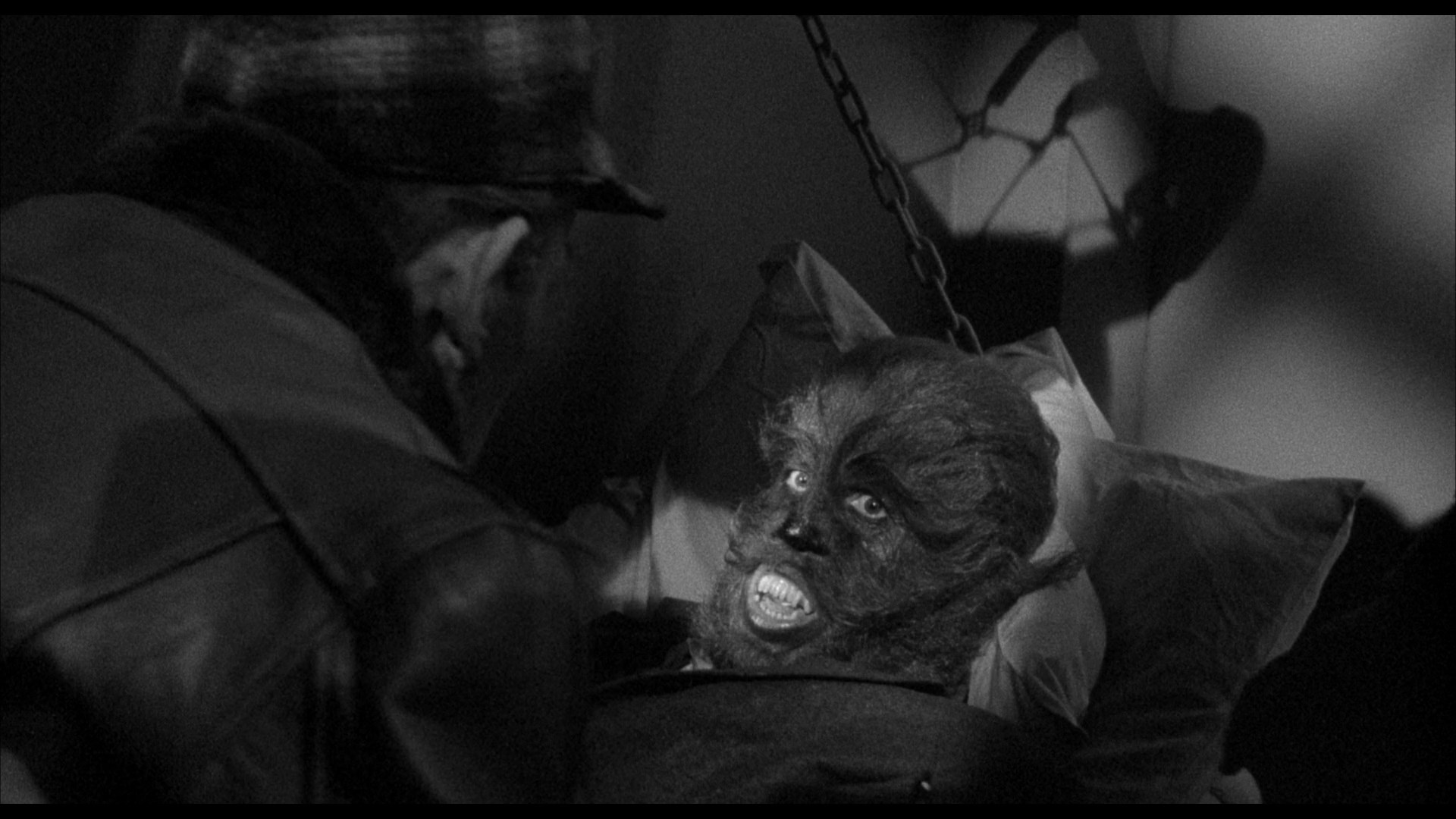 sexual orientation, distrust of scientists who had unleashed nuclear horrors,
sexual orientation, distrust of scientists who had unleashed nuclear horrors, 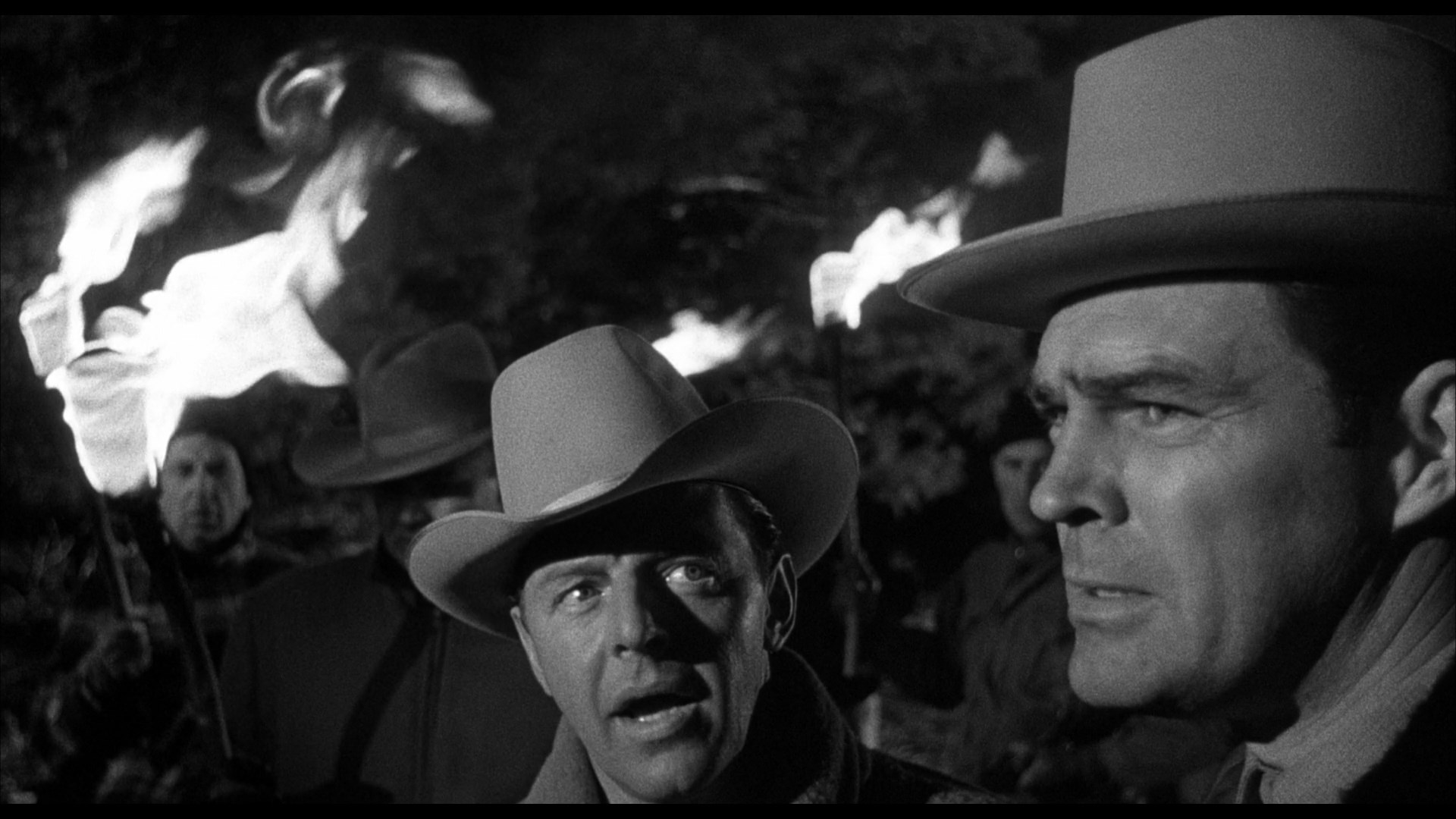 and the hostile treatment of outsiders by normal American communities. If that all sounds too heady, don't worry; this is also a fun werewolf movie in its own right with our tortured title character given the unique backdrop of snowy tourist favorite Big Bear in California. The dispensing of folklore-inspired werewolf rules here in place of unethical scientific meddling is not only appropriate for the time period but a harbinger of things to come like the following year's Blood of Dracula, which takes a similar approach with scientist-induced vampirism. This one has also been around on home video a lot including that Sony set, though the Arrow is easily the best of the lot with the film looking perfectly crisp even in the darkest night scenes. Lee Gambin, who knows his way around werewolf movies thanks to his book about the making of The Howling and his commentary on Return of the Vampire, offers a perceptive reading of the film here including thoughts on the film's approach to changing gender roles, the imagery used throughout to signify our werewolf's outsider status, and the atmosphere of paranoia, plus the history of werewolf cinema in general up to this point. Another intro by Newman (13m55s) focuses on Fred F. Sears here (including his much prolific work in westerns and the hit Rock Around the Clock) and the integration of classic monster tropes into 1950s atomic-age shockers. In "Beyond Window Dressing" (23m35s), critic Alexandra Heller-Nicholas narrates a visual essay about the female characters in these films including The Werewolf's action beginning with a woman who's "just one of the boys" and charting the variety of women populating the stories in a wide variety of personalities and plot functions. Of course, she really gets to dig into the gender politics of Atom Brain, the one that plays the most like a snapshot of '50s domestic attitudes. Also included here are the far less coherent Super 8 version (7m33s), the trailer, and an image gallery.
and the hostile treatment of outsiders by normal American communities. If that all sounds too heady, don't worry; this is also a fun werewolf movie in its own right with our tortured title character given the unique backdrop of snowy tourist favorite Big Bear in California. The dispensing of folklore-inspired werewolf rules here in place of unethical scientific meddling is not only appropriate for the time period but a harbinger of things to come like the following year's Blood of Dracula, which takes a similar approach with scientist-induced vampirism. This one has also been around on home video a lot including that Sony set, though the Arrow is easily the best of the lot with the film looking perfectly crisp even in the darkest night scenes. Lee Gambin, who knows his way around werewolf movies thanks to his book about the making of The Howling and his commentary on Return of the Vampire, offers a perceptive reading of the film here including thoughts on the film's approach to changing gender roles, the imagery used throughout to signify our werewolf's outsider status, and the atmosphere of paranoia, plus the history of werewolf cinema in general up to this point. Another intro by Newman (13m55s) focuses on Fred F. Sears here (including his much prolific work in westerns and the hit Rock Around the Clock) and the integration of classic monster tropes into 1950s atomic-age shockers. In "Beyond Window Dressing" (23m35s), critic Alexandra Heller-Nicholas narrates a visual essay about the female characters in these films including The Werewolf's action beginning with a woman who's "just one of the boys" and charting the variety of women populating the stories in a wide variety of personalities and plot functions. Of course, she really gets to dig into the gender politics of Atom Brain, the one that plays the most like a snapshot of '50s domestic attitudes. Also included here are the far less coherent Super 8 version (7m33s), the trailer, and an image gallery. 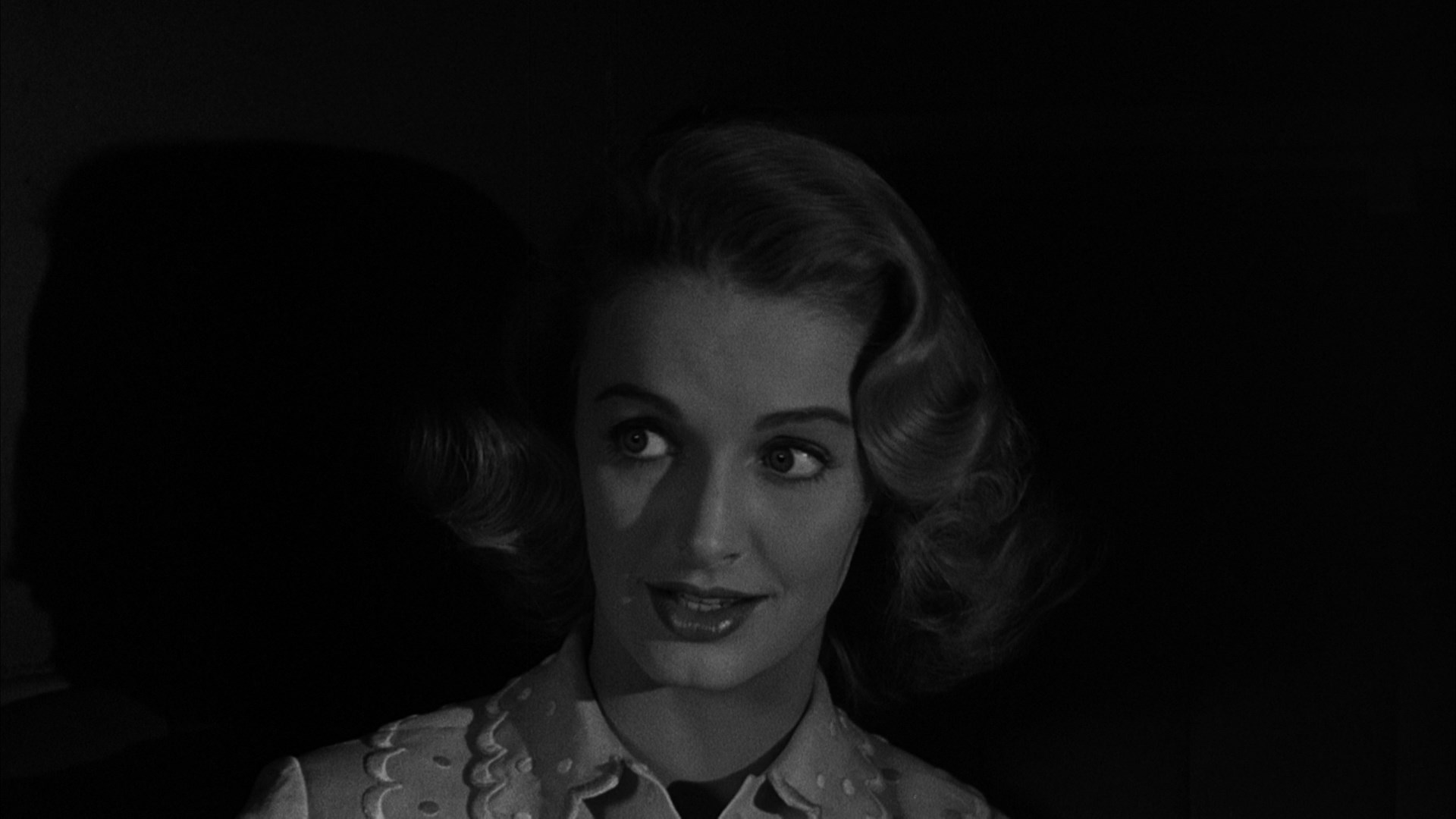 If Atom Brain exploited the idea of
If Atom Brain exploited the idea of 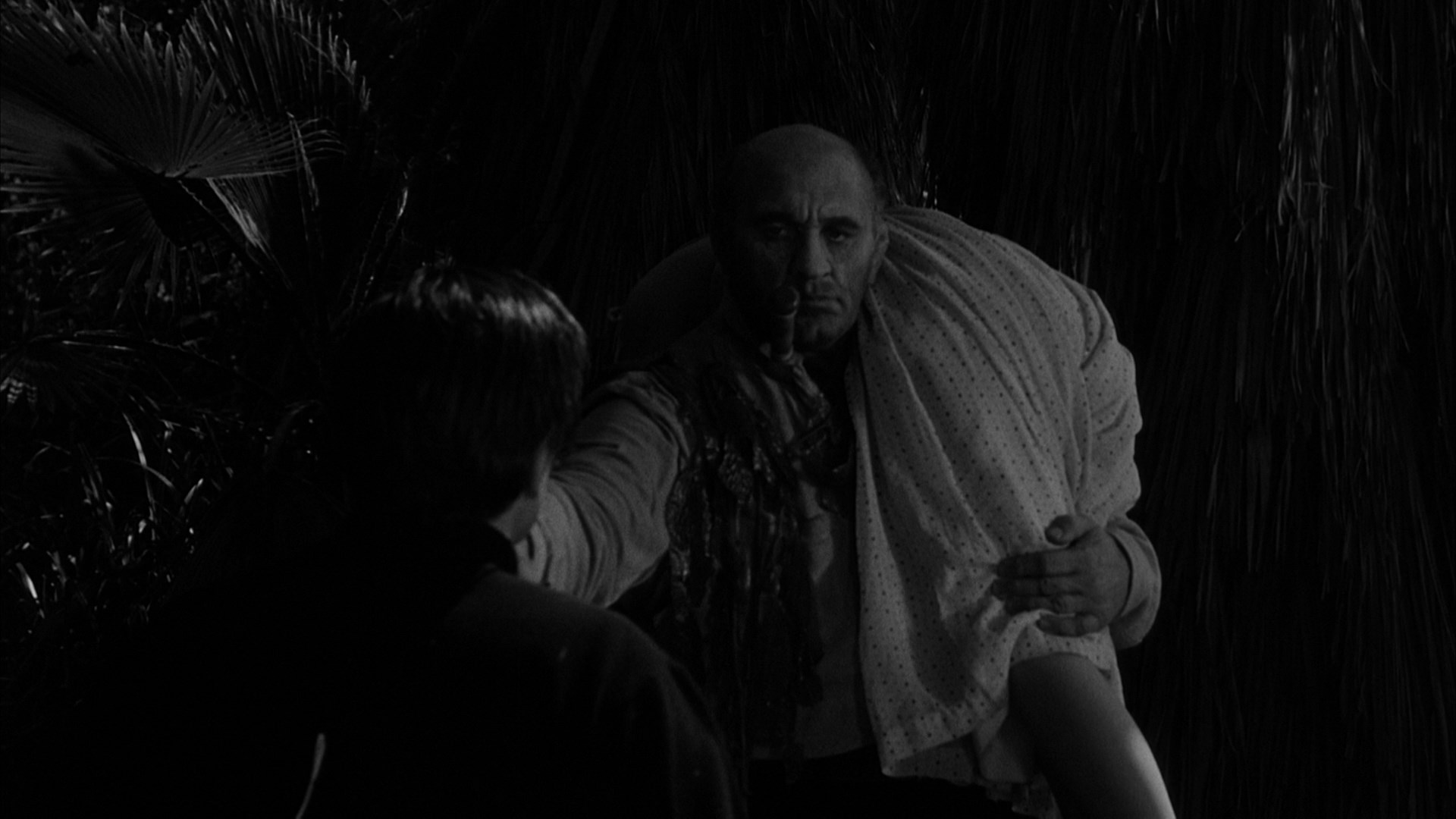 zombies without calling the out in the title, that situation is more than corrected with disc three featuring one of Katzman's most familiar titles, Zombies of Mora Tau. Here we get another genre twist with underwater undead, something that would be popularized much later with films like Zombie and Shock Waves, all wringing as much atmosphere as possible out of a studio-shot tropical horror adventure. The fun starts right away late at night as Jan (Russell) takes a cab to her mansion destination on the African coast only for the driver to blithely run over a shuffling man in the road. Her alarm is dismissed because, well, zombies are a bit of a nuisance in the area. She and her great-grandmother (Eaton) are set to play host to diver Jeff Clark (Palmer), who's been hired by the wealthy George Harrison (Ashley) and his sexpot wife, Mona (Attack of the 50-Foot Woman's Hayes) to swipe a fortune in diamonds stashed on a sunken ship. The problem, of course, is the zombies are the aquatic guards of the treasure, and it's only a matter of time before our good- and bad-hearted thieves alike run afoul of them.
zombies without calling the out in the title, that situation is more than corrected with disc three featuring one of Katzman's most familiar titles, Zombies of Mora Tau. Here we get another genre twist with underwater undead, something that would be popularized much later with films like Zombie and Shock Waves, all wringing as much atmosphere as possible out of a studio-shot tropical horror adventure. The fun starts right away late at night as Jan (Russell) takes a cab to her mansion destination on the African coast only for the driver to blithely run over a shuffling man in the road. Her alarm is dismissed because, well, zombies are a bit of a nuisance in the area. She and her great-grandmother (Eaton) are set to play host to diver Jeff Clark (Palmer), who's been hired by the wealthy George Harrison (Ashley) and his sexpot wife, Mona (Attack of the 50-Foot Woman's Hayes) to swipe a fortune in diamonds stashed on a sunken ship. The problem, of course, is the zombies are the aquatic guards of the treasure, and it's only a matter of time before our good- and bad-hearted thieves alike run afoul of them.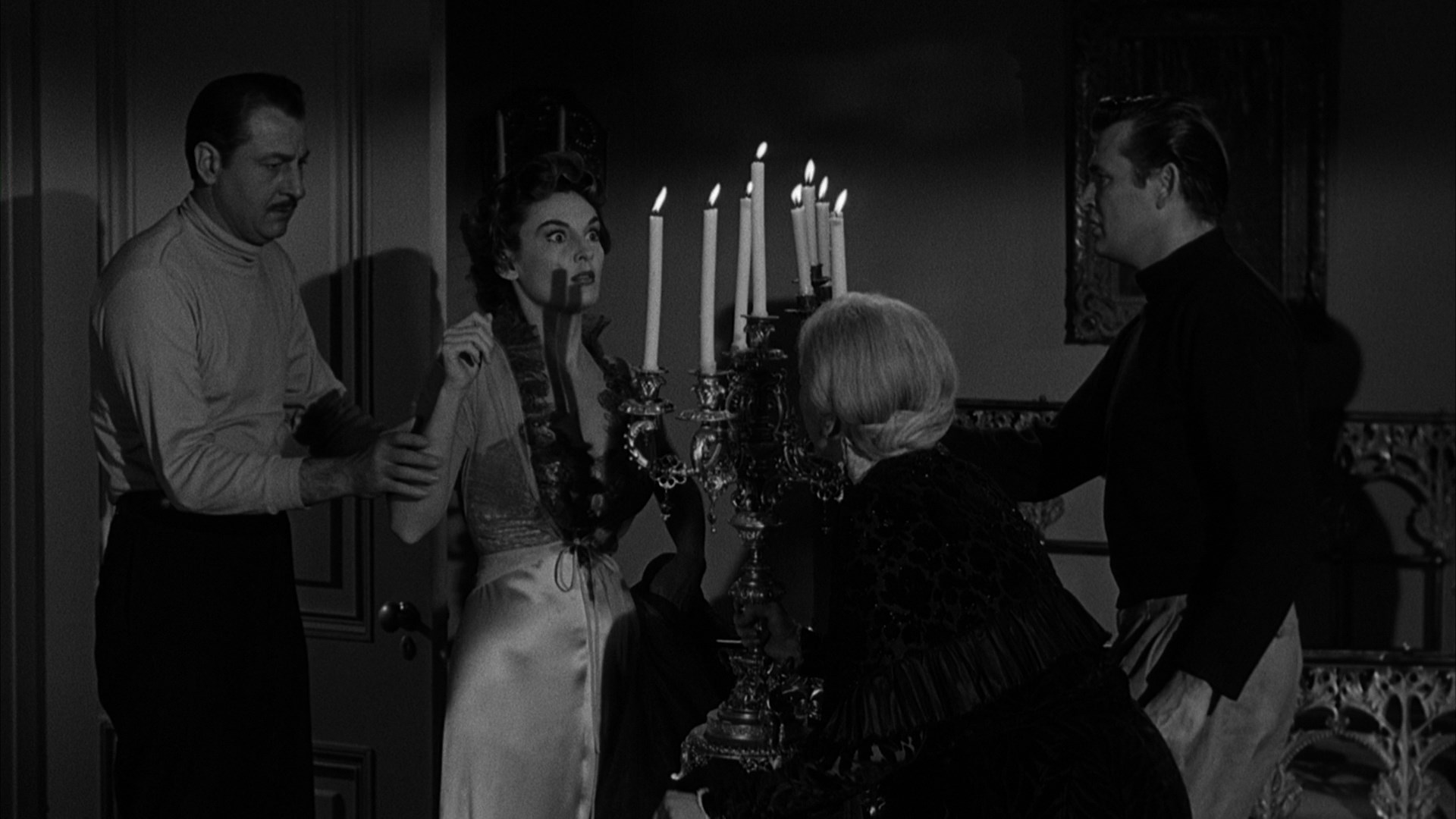 smoldering presence of Hayes, who completely dominates the camera
smoldering presence of Hayes, who completely dominates the camera 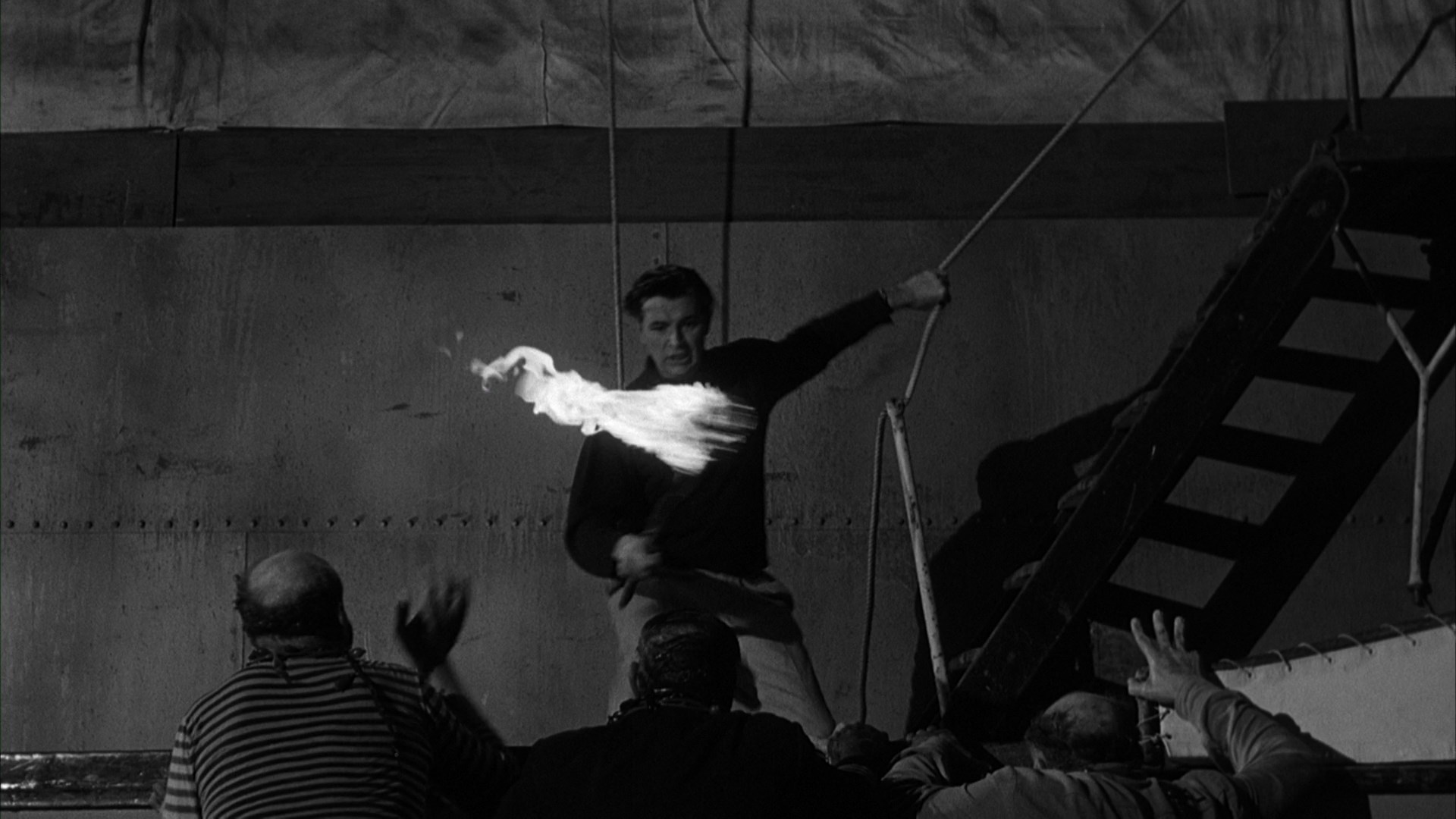 even when she's just standing around watching the other actors. This is easily the most traditionally Gothic horror film in the set as well, with its big spooky house, flickering candles, and nocturnal excursions beneath the waves giving it some nice ambiance for monster movie buffs. In addition to another top-notch transfer here with the proper matting, you get to play the film with a new Newman intro (7m35s) about the film's unique placement in the history of zombie cinema and the little quirks it offers for a theme that had largely been abandoned at this point since the days of Monogram programmers. Critic Kat Ellinger provides a new audio commentary for the feature itself, giving a packed academic reading for a film that nobody could've imagined possible a couple of decades ago. She gets to chew on a lot here including pre-Romero zombie films, the problem with identifying films as "B-pictures," Katzman's crank-em-out work ethic at the time, the impoverished state of '50s horror, the themes of class conflict and exploitation, and the Code-safe "saucy" elements that they managed to slip in, among many other subjects. Then it's visual essay time again as "Atomic Terror: Genre in Transformation" (19m48s) features critic Josh Hurtado dissecting the crossroads of science and traditional horror in these four films at the height of the atomic age, noting how attitudes of the time were a good opportunity to repackage the irrational with a more creative approach than was commonly recognized. Also included are the theatrical trailer (in the weakest condition of the four) and an image gallery.
even when she's just standing around watching the other actors. This is easily the most traditionally Gothic horror film in the set as well, with its big spooky house, flickering candles, and nocturnal excursions beneath the waves giving it some nice ambiance for monster movie buffs. In addition to another top-notch transfer here with the proper matting, you get to play the film with a new Newman intro (7m35s) about the film's unique placement in the history of zombie cinema and the little quirks it offers for a theme that had largely been abandoned at this point since the days of Monogram programmers. Critic Kat Ellinger provides a new audio commentary for the feature itself, giving a packed academic reading for a film that nobody could've imagined possible a couple of decades ago. She gets to chew on a lot here including pre-Romero zombie films, the problem with identifying films as "B-pictures," Katzman's crank-em-out work ethic at the time, the impoverished state of '50s horror, the themes of class conflict and exploitation, and the Code-safe "saucy" elements that they managed to slip in, among many other subjects. Then it's visual essay time again as "Atomic Terror: Genre in Transformation" (19m48s) features critic Josh Hurtado dissecting the crossroads of science and traditional horror in these four films at the height of the atomic age, noting how attitudes of the time were a good opportunity to repackage the irrational with a more creative approach than was commonly recognized. Also included are the theatrical trailer (in the weakest condition of the four) and an image gallery. 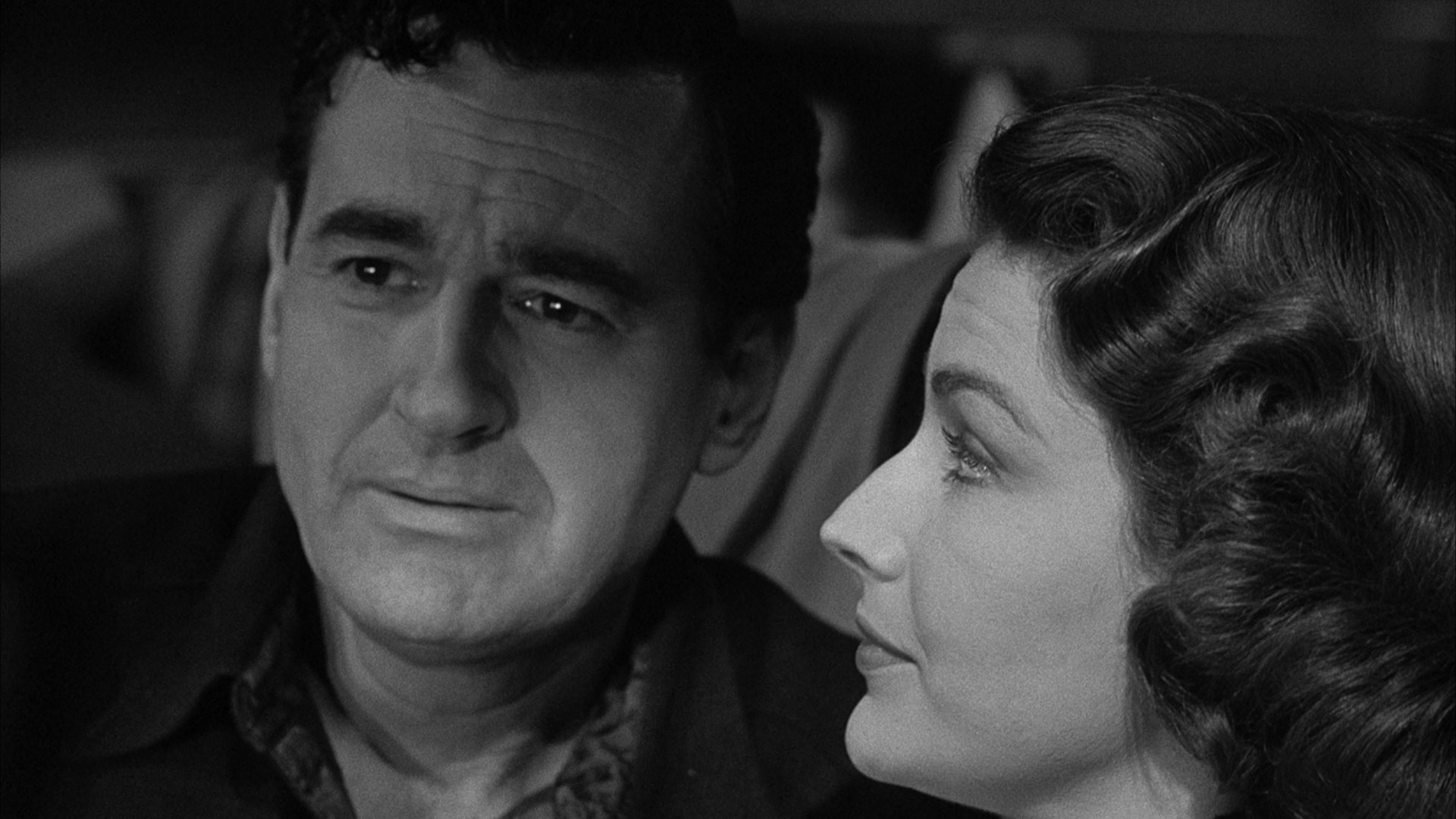 to forget
to forget 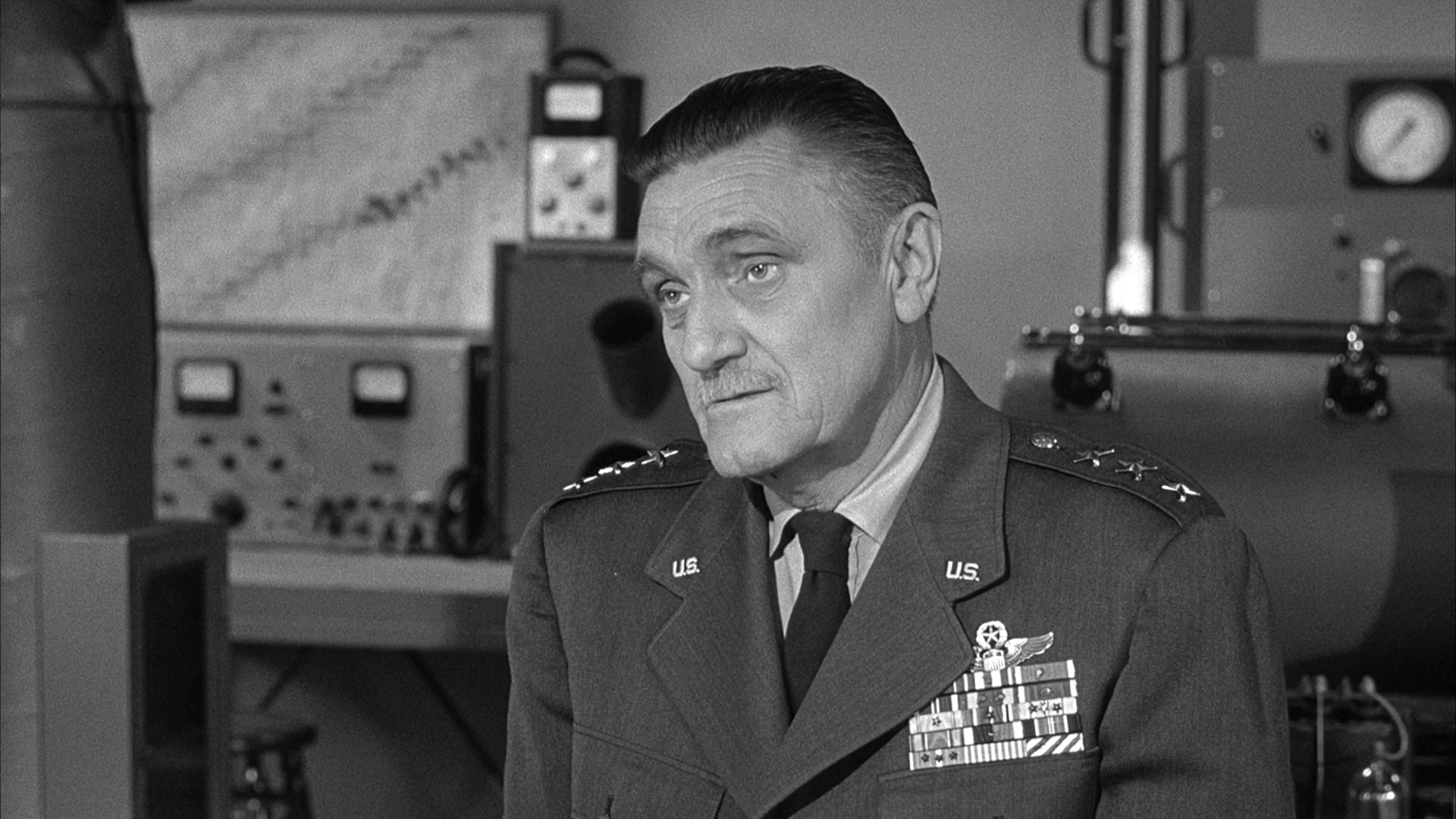 once you've seen it, the film sports a crazed monster design for the ages that would be rivaled only by the later Night of the Lepus... so brace yourselves. During a survey near the North Pole, aeronautics engineer Mitch MacAfee (This Island Earth's Morrow) believes he's seen a flying saucer and instigates an aerial investigation that leads to one plane disappearing without a trace. When he and colleague Sally Caldwell (Tarantula's Corday) head back to the U.S., their flight is ambushed by a flying menace that causes them to sound the alarm to the military. Now realizing that they're facing a giant bird that could take out an entire city, the clock is ticking to stop it before the lives of thousands are put at risk.
once you've seen it, the film sports a crazed monster design for the ages that would be rivaled only by the later Night of the Lepus... so brace yourselves. During a survey near the North Pole, aeronautics engineer Mitch MacAfee (This Island Earth's Morrow) believes he's seen a flying saucer and instigates an aerial investigation that leads to one plane disappearing without a trace. When he and colleague Sally Caldwell (Tarantula's Corday) head back to the U.S., their flight is ambushed by a flying menace that causes them to sound the alarm to the military. Now realizing that they're facing a giant bird that could take out an entire city, the clock is ticking to stop it before the lives of thousands are put at risk.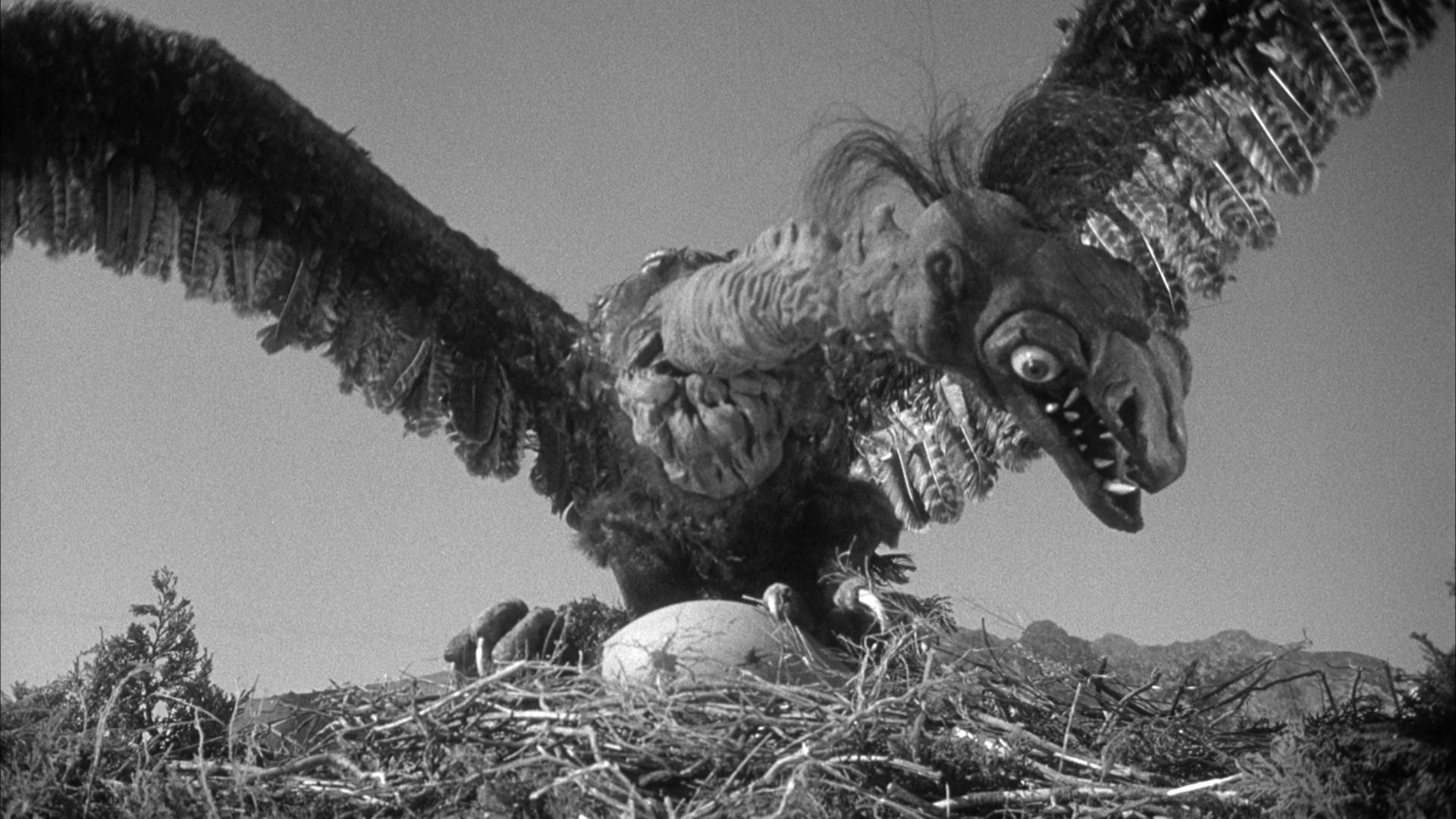 Charting the same path as the other films here from Sony DVD onward (plus a pit stop from Mill Creek in a budget Sci-Fi Classics set with 20 Million Miles to Earth, Mothra, and It Came from Beneath the Sea, and a no-frills Australian Blu-ray edition from Umbrella
Charting the same path as the other films here from Sony DVD onward (plus a pit stop from Mill Creek in a budget Sci-Fi Classics set with 20 Million Miles to Earth, Mothra, and It Came from Beneath the Sea, and a no-frills Australian Blu-ray edition from Umbrella 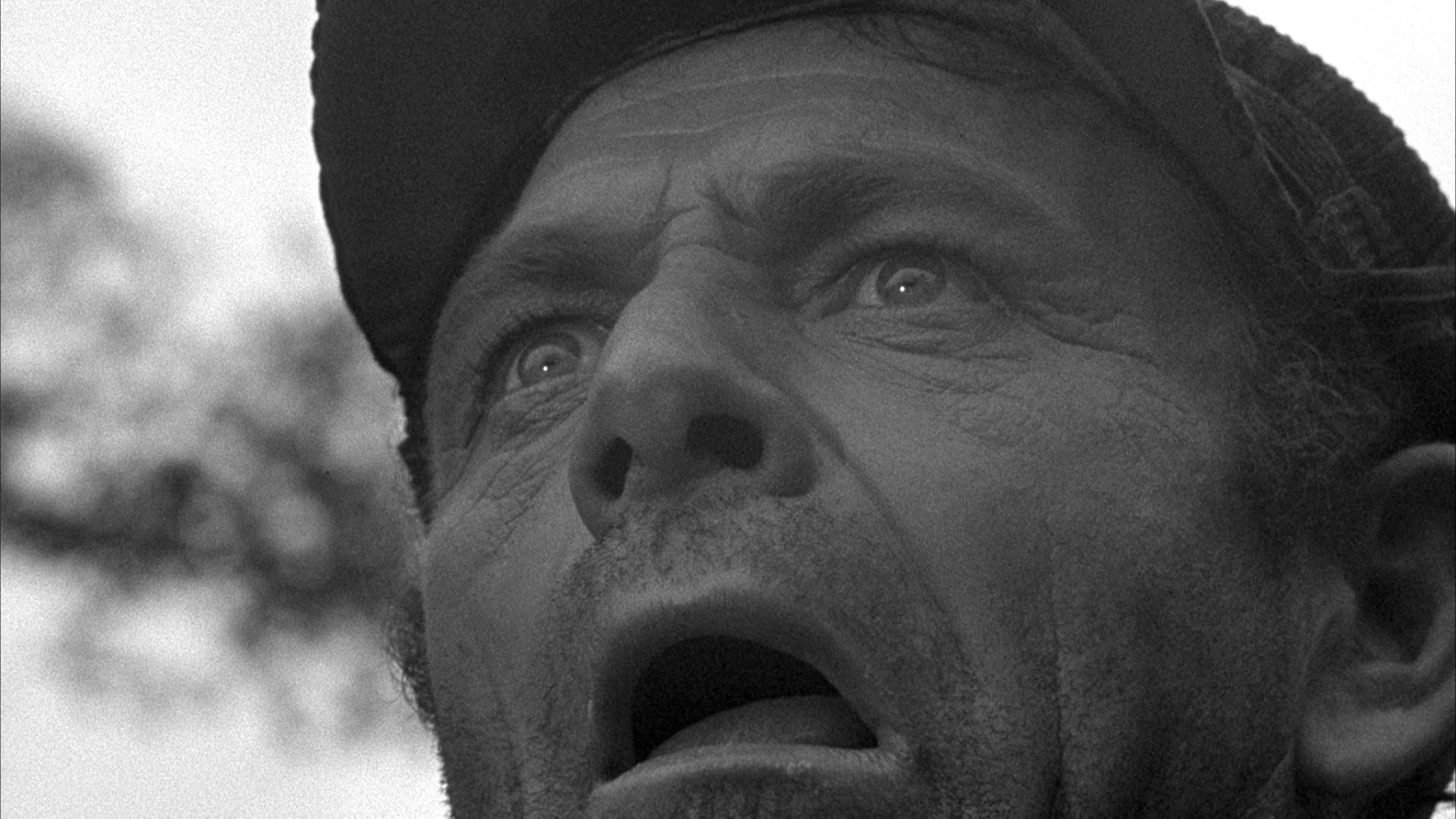 with The Werewolf), this one looks gorgeous here as well with no significant video or audio issues. Newman turns up one last time for a new video intro (12m27s) noting how the actors in this film were under the impression the special effects would be a tad more Harryhausen-worthy, the rumors about who exactly was responsible for the end product, and the film's unorthodox role in the giant monster rally at the time. A new audio commentary by critics Emma Westwood and Cerise Howard starts off with a flock of bird puns before mixing facts and humorous observations throughout, showing quite a bit of affection for this truly unique cinematic experience. In "Family Endangered!" (12m51s), critic Mike White studies the role of Cold War paranoia in the four Katzman films as a recurring factor involving the depictions of families under siege, the recurring theme of twisted science involving everything from radiation to covert serums, and older characters dispensing wisdom against potentially tragic quirks of fate. Also on hand are the rough quality and virtually incoherent Super 8 version (6m29s), the theatrical trailer (which proudly trumpets its creature right from the opening frames), and an image gallery. The set also comes with an illustrated 60-page book featuring new essays by Laura Drazin Boyes, Neil Mitchell, Barry Forshaw, Jon Towlson and Jackson Cooper, plus an 80-page art book with stills and artwork from each film and a new essay by Bissette, two double-sided posters showcasing the new artwork by Matt Griffin, and reversible sleeve options for each film.
with The Werewolf), this one looks gorgeous here as well with no significant video or audio issues. Newman turns up one last time for a new video intro (12m27s) noting how the actors in this film were under the impression the special effects would be a tad more Harryhausen-worthy, the rumors about who exactly was responsible for the end product, and the film's unorthodox role in the giant monster rally at the time. A new audio commentary by critics Emma Westwood and Cerise Howard starts off with a flock of bird puns before mixing facts and humorous observations throughout, showing quite a bit of affection for this truly unique cinematic experience. In "Family Endangered!" (12m51s), critic Mike White studies the role of Cold War paranoia in the four Katzman films as a recurring factor involving the depictions of families under siege, the recurring theme of twisted science involving everything from radiation to covert serums, and older characters dispensing wisdom against potentially tragic quirks of fate. Also on hand are the rough quality and virtually incoherent Super 8 version (6m29s), the theatrical trailer (which proudly trumpets its creature right from the opening frames), and an image gallery. The set also comes with an illustrated 60-page book featuring new essays by Laura Drazin Boyes, Neil Mitchell, Barry Forshaw, Jon Towlson and Jackson Cooper, plus an 80-page art book with stills and artwork from each film and a new essay by Bissette, two double-sided posters showcasing the new artwork by Matt Griffin, and reversible sleeve options for each film.